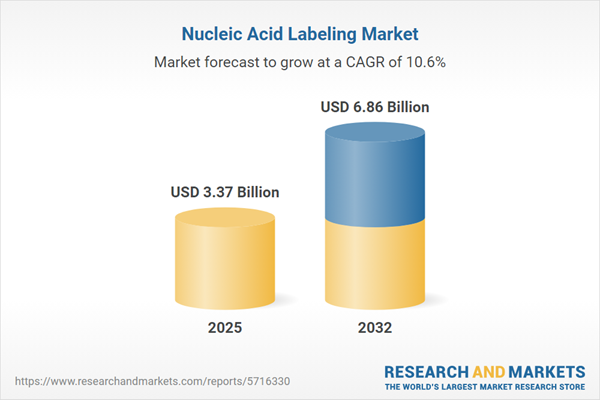Speak directly to the analyst to clarify any post sales queries you may have.
The nucleic acid labeling market is becoming increasingly central to scientific advancement, as organizations seek solutions that enable precise DNA and RNA analysis for applications across research, diagnostics, and therapeutic development.
Market Snapshot: Nucleic Acid Labeling Market Size and Growth
The nucleic acid labeling market expanded from USD 3.05 billion in 2024 to USD 3.37 billion in 2025 and is projected to reach USD 6.86 billion by 2032, reflecting a strong CAGR of 10.63%. This trajectory highlights increasing adoption across biotechnology, pharmaceutical, and research sectors, driven by technological advances and expanding application scope.
Scope & Segmentation
This report provides comprehensive analysis and detailed segmentation of the nucleic acid labeling market, outlining growth avenues for stakeholders worldwide. The market segmentation covers core offerings, technologies, applications, and regional demand.
- Label Types: Chemiluminescent, Enzymatic, Fluorescent (including Alexa Fluor, Cyanine, Fluorescein), and Radioactive tags for diverse detection capabilities.
- Applications: Diagnostics (covering Clinical and Forensic diagnostics), Research, and Therapeutics.
- End Users: Academic research institutes, Biotechnology firms, Contract research organizations, and Pharmaceutical companies.
- Technologies: Click chemistry, Enzymatic labeling, PCR labeling streamline workflows for multiplex detection and automation.
- Labeling Modes: Post-labeling (modification after synthesis) and Pre-labeling (integration during synthesis) shape workflow complexity and lead times.
- Regions: Americas (United States, Canada, Mexico, Brazil, Argentina, Chile, Colombia, Peru); Europe, Middle East & Africa (United Kingdom, Germany, France, Russia, Italy, Spain, Netherlands, Sweden, Poland, Switzerland, UAE, Saudi Arabia, Qatar, Turkey, Israel, South Africa, Nigeria, Egypt, Kenya); Asia-Pacific (China, India, Japan, Australia, South Korea, Indonesia, Thailand, Malaysia, Singapore, Taiwan).
- Key Companies: Thermo Fisher Scientific Inc., Merck KGaA, Roche Diagnostics International AG, QIAGEN N.V., Agilent Technologies, Inc., PerkinElmer, Inc., Bio-Rad Laboratories, Inc., Promega Corporation, New England Biolabs, Inc., Takara Bio Inc.
Key Takeaways for Decision-Makers
- Fluorescent dye development and enzymatic labeling are broadening multiplexing options and lowering detection thresholds, enabling advanced applications in single-molecule and high-throughput analysis.
- Integration of AI-driven analytics and digital platforms is improving data quality, supporting robust experimental interpretation and streamlined workflows for researchers and developers.
- Changing regulatory environments and supply chain disruptions have prompted increased emphasis on local manufacturing, dual-sourcing, and strategic supplier partnerships to ensure continuity and cost control.
- Innovation is being driven through strategic acquisitions, technology collaborations, and expansion of end-to-end product offerings that help meet specific user requirements.
- Segment-specific solutions—spanning from basic genomics research to clinical diagnostics and therapeutic monitoring—are propelling demand and fostering market diversification.
- Regional strategies now emphasize localization of production, tailored customer support, and adaptation to country-specific regulatory and reimbursement frameworks.
Tariff Impact: Supply Chain & Cost Structure Considerations
Recent United States tariff policy adjustments have altered the cost landscape for nucleic acid labeling reagents and equipment, particularly those sourced internationally. This shift is accelerating a move toward dual sourcing, inventory optimization, and the establishment of domestic manufacturing capabilities among reagent producers. Procurement and R&D teams are also adapting by adopting dynamic pricing and exploring pre-labeled probe solutions, helping to manage volatility and maintain supply reliability.
Methodology & Data Sources
This report employs a mixed-methods approach, combining systematic secondary research of literature and industry reporting with primary interviews among executives, scientists, and key opinion leaders. Quantitative data is statistically verified and triangulated with public sources, while expert panel validation ensures reliability and market relevance for forecasting and strategy assessment.
Why This Report Matters
- Enables benchmarking of technology adoption and workflow integration for strategic planning.
- Provides a granular view of market drivers, risks, and opportunities across applications, regions, and technology segments.
- Supports informed decision-making on supply chain management and investment prioritization in a shifting regulatory context.
Conclusion
The nucleic acid labeling market is evolving rapidly, shaped by innovation in chemistry, digital analytics, and supply chain management. Senior leaders can leverage this report to confidently navigate market complexities and secure sustainable growth in this dynamic sector.
Additional Product Information:
- Purchase of this report includes 1 year online access with quarterly updates.
- This report can be updated on request. Please contact our Customer Experience team using the Ask a Question widget on our website.
Table of Contents
3. Executive Summary
4. Market Overview
7. Cumulative Impact of Artificial Intelligence 2025
Companies Mentioned
The companies profiled in this Nucleic Acid Labeling market report include:- Thermo Fisher Scientific Inc.
- Merck KGaA
- Roche Diagnostics International AG
- QIAGEN N.V.
- Agilent Technologies, Inc.
- PerkinElmer, Inc.
- Bio-Rad Laboratories, Inc.
- Promega Corporation
- New England Biolabs, Inc.
- Takara Bio Inc.
Table Information
| Report Attribute | Details |
|---|---|
| No. of Pages | 199 |
| Published | October 2025 |
| Forecast Period | 2025 - 2032 |
| Estimated Market Value ( USD | $ 3.37 Billion |
| Forecasted Market Value ( USD | $ 6.86 Billion |
| Compound Annual Growth Rate | 10.6% |
| Regions Covered | Global |
| No. of Companies Mentioned | 11 |









